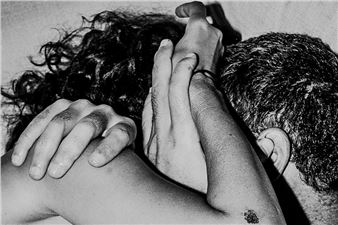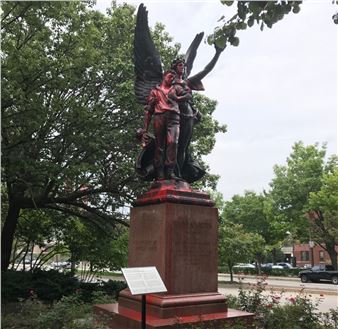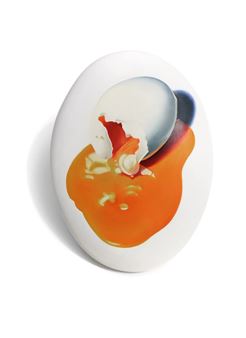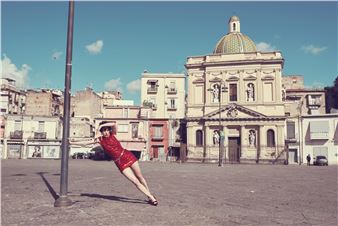One to One
When photography becomes material, a form, an attitude.
Start with photography. Not with painting. This is already an insistence, almost a provocation, given how the history of art seems to have always taken painting as its primary horizon, its sovereign reference. For a long time, photography was seen as merely a secondary tool: a document, an illustration, a copy. But if we reverse the narrative, if we take photography as a starting point—as a core, as an active principle—then history unfolds differently. Photography does not imitate painting; it creates. It shapes regimes of visibility, temporalities, and experiences. It is what inspires, what provokes, what makes us think and work.
The artists brought together in ONE TO ONE do not produce “photographs” in the traditional sense: they work from photography. Yet as soon as they start with the image, they let it drift. A photograph unravels, is embroidered, compressed, printed on fabric, sculpted in wire, or covered with natural imprints. The image is displaced, materialized differently, as if it refused the boundaries of its own medium. Each piece thus becomes a site of floating, residual memory, where the image is no longer presented as an archive to protect but as a transformed fragment, an active remainder.
In this gesture, there is a slowness that opposes the saturated flow of digital images. Embroidering a cyanotype takes time, just as leaving a botanical imprint on a print does. It is a different relationship with photography: no longer the speed of capture, but the temporality of the gesture. The photograph ceases to be merely looked at and becomes touched, worked, manipulated. It approaches sculpture, textile, and printmaking, without dissolving into them. It retains a shadow, a residue of its photographic origin.
…And if we were to imagine speaking with Jean-François Chevrier, he might say: photography is not a medium. Not just a medium. Rather, it is a regime. An operation. A device that displaces, that unsettles hierarchies. Thus, categories waver: art / document, painting / photo, visible / invisible.
Here, the works echo this movement. They overflow photography, exceed it, yet never abandon it. As if the photograph insists, persists. Like a ghost, yes. Like a ground. But an unstable, fractured ground, threatening to collapse or refract into other materials.
One might think photography defends itself as a relic, as evidence, as a precious remnant of the past. But here, that is not the case. The artists reject the fetish, they reject the print as sacred relic. They open the image, put it at risk, contaminate it. It becomes a porous surface, a traversed territory. It is not an end but a detour, a passage. It is in exile, and this exile produces new forms.
This displacement also affects the exhibition itself. Showing a transformed, disguised photograph engages the role of the exhibition device. Boris Groys wrote forcefully: the exhibition “heals” the image from its inability to show itself alone. Curare is to heal. But this cure is also a poison, a pharmakon: that which heals is also that which makes sick. The exhibition restores visibility, yet in doing so, alters it. ONE TO ONE does not hide this tension: it exposes it. Here, what is revealed is not only the photographic image turned into material, but the fragility of the act of exhibition itself.
From this perspective, the exhibition is not a simple accumulation of works. It is an essay, a constellation, a set of fragments in dialogue. Hans Ulrich Obrist has reminded us in his interviews: exhibitions have become a medium in themselves, a language with its own grammar, its deviations, its experiments. We no longer simply look at works; we traverse a situation. A situation where the time of the image—slowness, memory, transformation—interacts with the time of the visitor, the viewer, the passerby who hesitates, pauses, lingers.
Thus, ONE TO ONE is not a closed hypothesis: it does not seek to prove. On the contrary, it connects, it proposes: the works do not resemble each other, they do not converge toward a single conclusion. They coexist in tension: between disappearance and preservation, between materiality and erasure. Within this tension, photography reinvents itself. It is no longer recording; it is gesture.
So, what remains? Perhaps only this experience: thinking of photography as memory in motion. Not as a frozen past, but as a present that dissolves and recomposes. Not as an archive, but as a trace in becoming. An image that survives by choosing slowness, by allowing itself to be handled, embroidered, compressed. A photograph that no longer merely wants to be seen but allows itself to be touched.
There is a form of resistance in these gestures. Resistance to the acceleration of digital flows. Resistance to the standardization of images. Resistance to forgetting. But also openness: for in transforming, photography exposes itself to otherness, to the chance of materials, to the hands that pass through it. It becomes hospitable. It allows itself to be shared differently.
Perhaps this is the meaning of the title: ONE TO ONE—a cloud made of shadows, remnants, fragments of a life in constant change: not memory as intact archive, but as an ongoing process. Fragile, uncertain, yet persistent memory. Memory materialized in thread, in imprint, in matter. And a reminder that to see an image is never merely to look at it: it is also to inhabit it, traverse it, touch it.
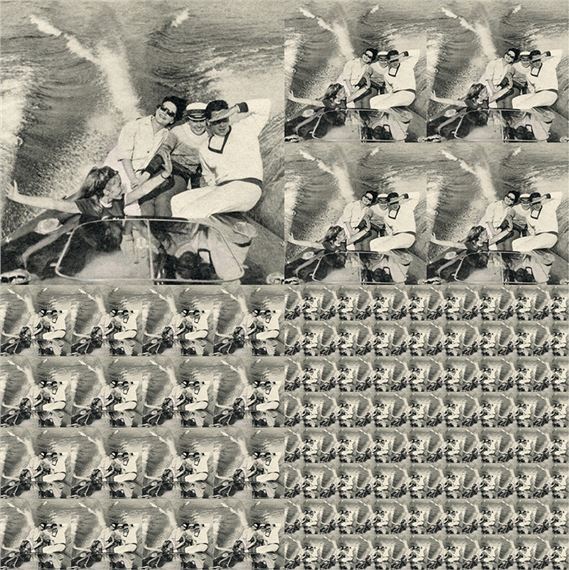
Recommended for you
When photography becomes material, a form, an attitude.
Start with photography. Not with painting. This is already an insistence, almost a provocation, given how the history of art seems to have always taken painting as its primary horizon, its sovereign reference. For a long time, photography was seen as merely a secondary tool: a document, an illustration, a copy. But if we reverse the narrative, if we take photography as a starting point—as a core, as an active principle—then history unfolds differently. Photography does not imitate painting; it creates. It shapes regimes of visibility, temporalities, and experiences. It is what inspires, what provokes, what makes us think and work.
The artists brought together in ONE TO ONE do not produce “photographs” in the traditional sense: they work from photography. Yet as soon as they start with the image, they let it drift. A photograph unravels, is embroidered, compressed, printed on fabric, sculpted in wire, or covered with natural imprints. The image is displaced, materialized differently, as if it refused the boundaries of its own medium. Each piece thus becomes a site of floating, residual memory, where the image is no longer presented as an archive to protect but as a transformed fragment, an active remainder.
In this gesture, there is a slowness that opposes the saturated flow of digital images. Embroidering a cyanotype takes time, just as leaving a botanical imprint on a print does. It is a different relationship with photography: no longer the speed of capture, but the temporality of the gesture. The photograph ceases to be merely looked at and becomes touched, worked, manipulated. It approaches sculpture, textile, and printmaking, without dissolving into them. It retains a shadow, a residue of its photographic origin.
…And if we were to imagine speaking with Jean-François Chevrier, he might say: photography is not a medium. Not just a medium. Rather, it is a regime. An operation. A device that displaces, that unsettles hierarchies. Thus, categories waver: art / document, painting / photo, visible / invisible.
Here, the works echo this movement. They overflow photography, exceed it, yet never abandon it. As if the photograph insists, persists. Like a ghost, yes. Like a ground. But an unstable, fractured ground, threatening to collapse or refract into other materials.
One might think photography defends itself as a relic, as evidence, as a precious remnant of the past. But here, that is not the case. The artists reject the fetish, they reject the print as sacred relic. They open the image, put it at risk, contaminate it. It becomes a porous surface, a traversed territory. It is not an end but a detour, a passage. It is in exile, and this exile produces new forms.
This displacement also affects the exhibition itself. Showing a transformed, disguised photograph engages the role of the exhibition device. Boris Groys wrote forcefully: the exhibition “heals” the image from its inability to show itself alone. Curare is to heal. But this cure is also a poison, a pharmakon: that which heals is also that which makes sick. The exhibition restores visibility, yet in doing so, alters it. ONE TO ONE does not hide this tension: it exposes it. Here, what is revealed is not only the photographic image turned into material, but the fragility of the act of exhibition itself.
From this perspective, the exhibition is not a simple accumulation of works. It is an essay, a constellation, a set of fragments in dialogue. Hans Ulrich Obrist has reminded us in his interviews: exhibitions have become a medium in themselves, a language with its own grammar, its deviations, its experiments. We no longer simply look at works; we traverse a situation. A situation where the time of the image—slowness, memory, transformation—interacts with the time of the visitor, the viewer, the passerby who hesitates, pauses, lingers.
Thus, ONE TO ONE is not a closed hypothesis: it does not seek to prove. On the contrary, it connects, it proposes: the works do not resemble each other, they do not converge toward a single conclusion. They coexist in tension: between disappearance and preservation, between materiality and erasure. Within this tension, photography reinvents itself. It is no longer recording; it is gesture.
So, what remains? Perhaps only this experience: thinking of photography as memory in motion. Not as a frozen past, but as a present that dissolves and recomposes. Not as an archive, but as a trace in becoming. An image that survives by choosing slowness, by allowing itself to be handled, embroidered, compressed. A photograph that no longer merely wants to be seen but allows itself to be touched.
There is a form of resistance in these gestures. Resistance to the acceleration of digital flows. Resistance to the standardization of images. Resistance to forgetting. But also openness: for in transforming, photography exposes itself to otherness, to the chance of materials, to the hands that pass through it. It becomes hospitable. It allows itself to be shared differently.
Perhaps this is the meaning of the title: ONE TO ONE—a cloud made of shadows, remnants, fragments of a life in constant change: not memory as intact archive, but as an ongoing process. Fragile, uncertain, yet persistent memory. Memory materialized in thread, in imprint, in matter. And a reminder that to see an image is never merely to look at it: it is also to inhabit it, traverse it, touch it.
Artists on show
- Adéla SouÄŤková
- Alexander Morozov
- Anila Rubiku
- Anne Deguelle
- Arina Antonova
- Chemsedine Herriche
- Dimitri Kostyukov
- Ekaterina Vassilieva
- Esmeralda Kosmatopoulos
- Hans Ulrich Obrist
- Jorge Rosano Gamboa
- Kwama Frigaux
- Leyla Cardenas
- Louisa Barbari
- Luca Resta
- Maxim Zmeyev
- Nasreddine Bennacer
- Nina Ivanović
- Sebastian Riemer
- Tracey Moffatt
- Tuck Muntarbhorn
- Vincent Lemaire
Contact details


 ARTISTS
ARTISTS










